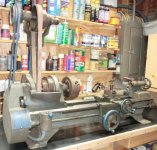My lathe is a 9" A V Carroll, which is very similar to a 9" South Bend. I am posting here because I can't find anyone else with my model. I am hoping you SB folks can help.
The problem I am trying to solve is terrible chatter on even a light cut on an 8" steel test bar. My experience is limited to a mini-lathe, which required a lot of tinkering to remove chatter and giving me some experience on the topic.
The Carroll is a bench top 9" with the motor behind the head stock powering an overhead pulley that connects to the head stock via flat belt. It has bronze split bearings on the head stock. I added a QCTP after the below picture. (The T-nut is not the problem.)
Here is a picture:

I am guessing the problem falls into one of 3 categories: 1. Excessive play, 2. Machine rigidity, or 3. Tooling.
Any comments on the following would be appreciated.
1. The head stock has .003" vertical play, but has about .006" horizontal play. The carriage has around .005" of play. I have tried tightening up the carriage and cross slides to the point they almost will not move leaving only the head stock play as the variable and this did not fix the problem. Most SB guys are adjusting vertical play with shims. I have not seen any discussion about horizontal play. I don't know if anything can be done about horizontal play. Do these numbers sound acceptable or bad enough to cause the chatter issue?
2. The lathe is mounted on a wooden bench reinforced with steel including 1/4" steel top. It is bolted to the bench, but the bench can sway a bit. The motor is mounted on a floating pin (like a hinge) that tensions the belt via gravity pulling the motor. I noticed that when it is running, the motor jumps around a bit and creates some vibration. Does anyone with experience know of this causing bed flex and/or chatter?
3. Proper tooling is a bit of a mystery. I would assume that the info in the South Bend manual would apply, which calls for significant positive rake and the cutter tip 3/64" above the center. That's based on using a lantern tool holder. I am going on the assumption that using a QCTP changes things a bit and that the cutter should be on the center. A HSS tool ground with positive rake still had significant chatter and poor finish. I have not tried a carbide insert yet due to not having a correct size for the AXA holder. I am a little hesitant to spend any more money on this thing until I can be sure it will work. Is there a tool setup that would be least likely to cause chatter?
MP
The problem I am trying to solve is terrible chatter on even a light cut on an 8" steel test bar. My experience is limited to a mini-lathe, which required a lot of tinkering to remove chatter and giving me some experience on the topic.
The Carroll is a bench top 9" with the motor behind the head stock powering an overhead pulley that connects to the head stock via flat belt. It has bronze split bearings on the head stock. I added a QCTP after the below picture. (The T-nut is not the problem.)
Here is a picture:

I am guessing the problem falls into one of 3 categories: 1. Excessive play, 2. Machine rigidity, or 3. Tooling.
Any comments on the following would be appreciated.
1. The head stock has .003" vertical play, but has about .006" horizontal play. The carriage has around .005" of play. I have tried tightening up the carriage and cross slides to the point they almost will not move leaving only the head stock play as the variable and this did not fix the problem. Most SB guys are adjusting vertical play with shims. I have not seen any discussion about horizontal play. I don't know if anything can be done about horizontal play. Do these numbers sound acceptable or bad enough to cause the chatter issue?
2. The lathe is mounted on a wooden bench reinforced with steel including 1/4" steel top. It is bolted to the bench, but the bench can sway a bit. The motor is mounted on a floating pin (like a hinge) that tensions the belt via gravity pulling the motor. I noticed that when it is running, the motor jumps around a bit and creates some vibration. Does anyone with experience know of this causing bed flex and/or chatter?
3. Proper tooling is a bit of a mystery. I would assume that the info in the South Bend manual would apply, which calls for significant positive rake and the cutter tip 3/64" above the center. That's based on using a lantern tool holder. I am going on the assumption that using a QCTP changes things a bit and that the cutter should be on the center. A HSS tool ground with positive rake still had significant chatter and poor finish. I have not tried a carbide insert yet due to not having a correct size for the AXA holder. I am a little hesitant to spend any more money on this thing until I can be sure it will work. Is there a tool setup that would be least likely to cause chatter?
MP

